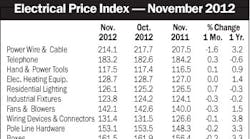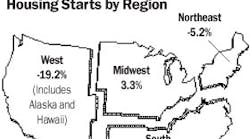Latest from Mag
People - Dec 21, 2012
Obituaries - Dec 21, 2012
November EPI Index Shows No Change
Housing Starts Dip 4% in November
Electrical Marketing - December 21, 2012
Around the Industry - Dec 21, 2012
Electrical distributors, manufacturers and independent reps are used to some pretty radical price changes for wire and cable because of the wild swings in copper pricing. But they probably didn't see double-digit increases in lamp prices coming until they started opening letters from their suppliers regarding some pretty hefty price hikes over the past few weeks.
Drastic reductions in Chinese exports of the rare earth metals used in many different types of lamps have touched off a global surge in pricing for these metals. TCP Inc., Aurora, Ohio, sent a bulletin to its distributors that said that the rare-earth phosphor used in compact fluorescent lamps reportedly rose up to 800 percent. Rocked by increases in their materials costs, lighting manufacturers have announced a slew of price increases.
Letters from senior executives at GE, Osram Sylvania, Philips Lighting and TCP now posted on www.fsgi.com, the web-site of Austin, Texas-based Facility Solutions Group, explained the shortage of rare earth metals and announced price increases from five percent to 25 percent — depending on the types of lamps — and increases in ballast prices of up to approximately 10 percent.
Industry observers don't see any quick remedy for the shortage, at least until China lifts the export sanctions, or until mining companies in other nations can ramp up production in their mines for rare earth metals. In many cases, these mines have been closed over the past decade because they couldn't compete with the pricing offered by the government-controlled Chinese mining companies.
Higher prices for these rare earth metals will support domestic mining say some lighting and mining experts, but they also expect it to take several years for these mines to ramp up to full production. However, it's not hard to find media reports about U.S. mines from California to Nebraska that may once again be producing rare earth metals. On its website, lighting distributor Priority Lighting, Las Vegas, had this to say about the potential to ramp up U.S. production of rare earth metals: “The flip side of the coin is that as prices rise, mining these rare elements once again becomes a profitable enterprise. U.S. mines are producing again. Further exploration of future sites has begun in Wyoming, Alaska and Idaho. The most optimistic estimates state that the U.S. can become self-sufficient in rare earth production by 2015, though more cautious analysts believe it will take more than a decade.”
Further down the road, rare earth metals may be mined offshore. A huge deposit estimated at 100 billion tons was recently found on the ocean floor off Japan's coast a depth of 11,500 feet to 20,000 feet. If it can be mined profitably, it could break China's lock on the market. China currently produces an estimated 95 percent of the world's supply of rare earth metals.
Meanwhile, some distributors and manufacturers are focusing on keeping their customers informed about the reasons for the shortage and the latest rounds of pricing increases. Summit Electric Supply, Albuquerque, and Facility Solutions Group are using their websites to keep customers informed about the shortage and impending price increases. A posting at www.fsgi.com said, “Rare earth oxides are a critical component in the making of the phosphors used in linear and compact fluorescent lamps. China controls over 95% of the global market for these Rare Earth Oxides. The Chinese Government has imposed taxes for environmental clean-up and limitations on the amount of oxides available for export. The combination of limited production and imposed taxes to mine and produce these elements has led to unprecedented cost increases that started in January of this year.
“Another complicating factor is that varying phosphor mixes at the individual product level affect the amount of increase for that product differently. It is not a flat increase across all products, but rather a variance by each product depending on lamp color, lamp tube diameter, and lamp wattage.
“As a result, every major lamp manufacturer (GE, OSI (Osram Sylvania) Philips, TCP, Maxlite, etc.) has announced scheduled price increases that began on July 5th and will likely continue at monthly intervals for the foreseeable future through 2012. The manufacturers have stated they will do all they can to manage and control the price increases by tying them only to the inflationary pressure associated with the rare earth elements.
“FSG is committed to helping our customers best navigate these volatile times. We are investing in more inventory to ensure that you are not affected by the scarcity and we will only be passing on the percentage cost increase on a SKU by SKU basis as they occur.”

